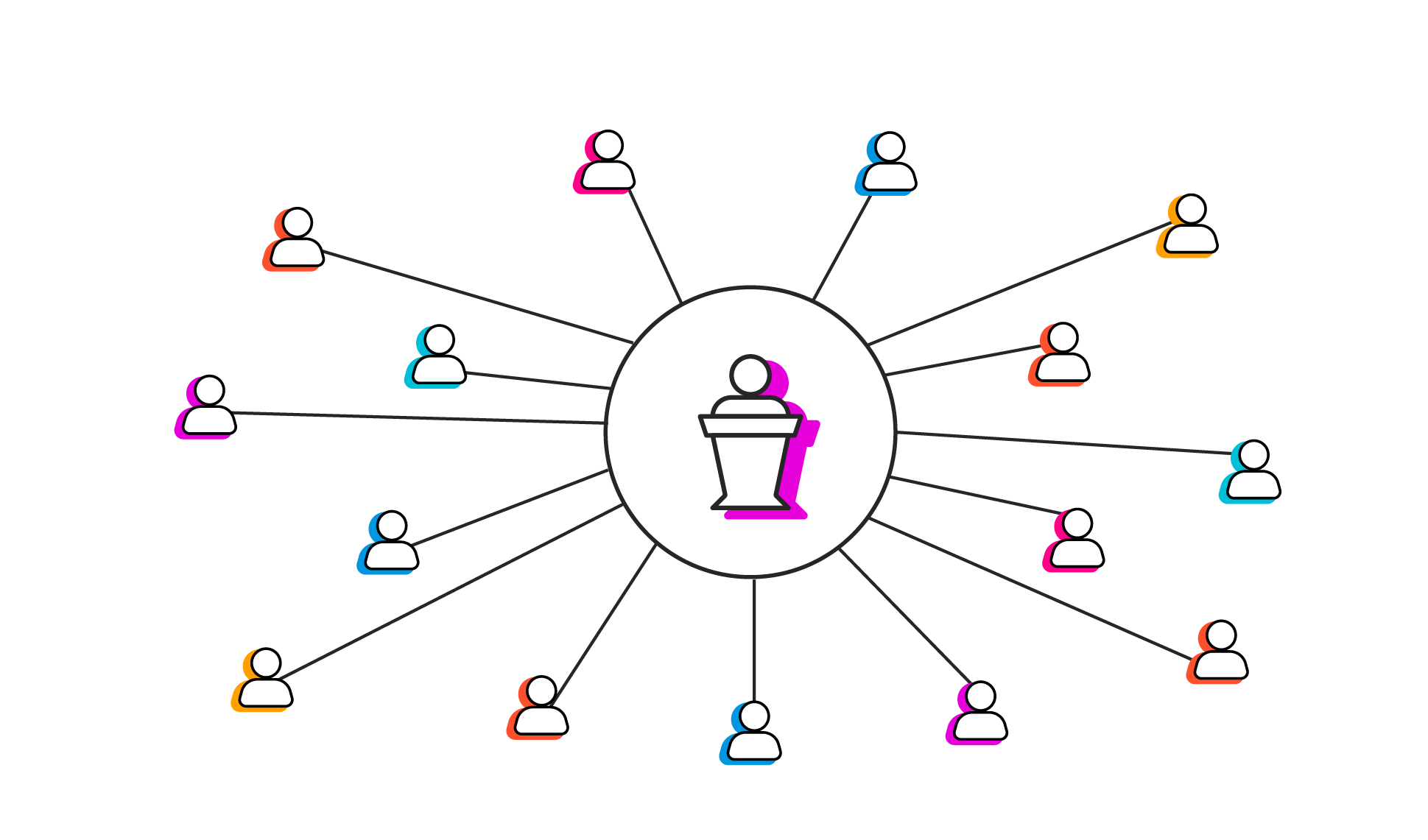Always-On Campaigning: What Is It and Why Texting Is Integral For Your Strategy to Succeed
Discover how an always-on campaign approach to political texting can enhance voter engagement.

Like marketers, political campaigns want to interact and engage with their audience, so it’s no wonder they’ve borrowed a few pages from the marketing playbook.
After all, marketing strategies are designed to capture an audience’s attention and motivate them to take action—and that’s exactly what political campaigns aim to do. These campaigns want to pique voters’ interest, gain their support, get them to volunteer, and encourage them to cast ballots.
In our guide below, we’ll examine political campaigns' marketing tactics to boost voter engagement, such as always-on marketing and SMS texting.
Always-On Campaigning: Leveraging Texting for Political Success
Always-on marketing involves maintaining a steady flow of content to communicate with an audience regularly. However, marketers aren’t the only ones who use this strategy to boost engagement—political campaigns also use it to interact with constituents.
Below, we’ll unpack always-on campaigning, discuss how it compliments political texting strategies, and explore how campaigns use these methods to increase voter engagement.
Understanding Always-On Campaigns
When marketers use always-on campaign strategies, they strive to be constantly present. They continuously interact with their audience and are always available when their customers need them. Because of this, many incorporate AI and automated messaging to quickly and efficiently communicate with their audience 24/7.
Sometimes referred to as continuous marketing activities, this approach doesn’t have a start and end date because it’s always running. It’s the opposite of one-off campaigns with a brief life cycle and a finite number of predetermined interactions with an audience. Instead, it supports nonstop communication, which usually involves a combination of outreach efforts, like SMS texts, newsletters, social media posts, and targeted ads. Some call this a “full-funnel strategy,” meaning marketers can reach individual customers at all times, no matter where they are in the customer journey.
However, it’s important to note that always-on marketing doesn’t mean relentlessly blasting audiences with unnecessary information around the clock. Instead, an always-on marketing campaign is a well-thought-out and calculated approach that delivers personalized and relevant information to audiences where and when needed.
Now, what does "always-on campaigning" mean in the context of modern political strategies? Always-on campaigning incorporates the same methods as always-on marketing to communicate and engage with voters. Always-on political campaigns continuously interact with voters on multiple channels to mobilize them to take action.
For instance, an always-on campaign might text out educational information about a candidate, send invitations to an in-person political rally, and host a virtual Q&A. These ongoing efforts help motivate voters to participate and engage with the campaign all the way until it’s time for them to cast their ballots.
Benefits of Always-On Campaigning
The election cycle can last a while, depending on the election. For example, for a congressional election, the election period starts the day after a general election and ends on the day of the next general election for that office.
During that stretch, a campaign needs to capture voters’ attention and maintain it until election day. That’s where always-on campaigning steps up to the plate.
This strategy helps campaigns connect with voters, which is beneficial for gaining their support. Constant contact helps increase voters’ recognition of the candidate and educate them about the candidate’s platform. The continual communication also encourages voters to interact with the content, familiarize themselves with the candidate’s goals and issues, and ask questions to determine whether the candidate aligns with their preferences.
After all that nonstop interaction with voters throughout the election cycle, the goal is for those voters to feel informed and empowered enough to show up on election day and vote in favor of that campaign’s candidate.
Leveraging Always-On Campaigning to Your Advantage
How can political campaigns leverage always-on campaigning to their advantage? They can do this by incorporating various mobile outreach strategies, such as SMS texts and social media, to stay engaged with voters and support real-time interactions.
Integrating Mobile Outreach Strategies
Campaigns use mobile outreach strategies like SMS texting and social media to support nonstop communication with voters. For example, campaigns can craft social media posts or send SMS texts that provide voters with a link to a blog post, a video clip, a survey, or a poll. Voters can then interact with this content, learning about the candidate, asking questions, or even replying with their own feedback regarding the campaign.
These ongoing posts and messages help raise awareness, educate, and persuade voters as they foster an ongoing conversation around the campaign and its candidate.

Benefits of Staying Actively Engaged with Voters
What’s so important about staying in constant contact with voters anyway? There’s a lot of noise out there, and it’s easy for voters to get distracted or lose interest in politics. Of course, a campaign doesn’t want to get lost in all that noise, so they must stay top of mind.
These campaigns can’t just show up now and again and expect to make an impression on voters—they need to be a constant presence in their lives. Therefore, campaigns must constantly stay engaged with voters to help them remember and recognize their candidate. The more voters see and engage with a campaign’s content, the more likely they are to consider voting for that candidate and casting a ballot.
Political Texting Strategy
A political texting strategy should be part of any campaign’s always-on approach. But why is text message outreach considered essential in political campaigns? Text message outreach is considered essential in political campaigns due to its high open and engagement rates compared to other forms of communication. Essentially, it increases the campaign's chances of seeing their content and connecting with their voters.
The Significance of Political Texting in Modern Campaigns
That brings us to our next question: What is the significance of a political texting strategy in modern campaigns? The strategy provides a way of quickly, efficiently, and effectively communicating with voters in real-time.
Political texting provides campaigns with a convenient way of reaching voters. After all, these messages are sent straight to their mobile phones— many of which are probably in their hands or pockets as we write this—and 98% are open and read. Now compare that to the 18% open rate of emails, and you can see why texting is considered such a valuable means of communication.
Furthermore, texting facilitates two-way conversations, allowing campaigns to talk with voters in real-time. This can help build trust and foster a relationship between the campaign and a voter, which could increase voter loyalty and support.

Effectiveness of Direct Voter Engagement via Text Messages
Another important factor is that political text messaging is a form of direct voter engagement. This means it’s a method of directly communicating with voters to help increase their involvement in the campaign.
That said, how can political campaigns effectively engage voters via texting? They can send them personalized, relevant content that motivates them to take action.
To increase voter engagement via texting, campaigns can text voters information about polling locations, candidate updates, and reminders about upcoming elections and early voting. This could include texting them a survey to gather feedback, a video about the candidate’s goals, or a request to volunteer for the campaign.
Examples of Successful Political Texting Strategies
Let’s look at some examples of voter engagement via texting.
One example involves using political text messages to educate voters about a candidate’s issues. In this case, the campaign might text voters a blog link to an article describing the candidate’s stance on climate change, encouraging them to read more about the campaign’s initiatives. That blog article could include an infographic, video clip, and links to additional resources so the voter has plenty of information to explore.
Sending invitations to in-person events is another successful political texting strategy. The campaign hosts an in-person community event where their candidate plans to speak and hold a Q&A with voters. To drum up interest and increase attendance at the event, the campaign could text invitations to those voters living within driving distance of the event. The campaign could even consider giving freebies to those who RSVP by a certain date to boost excitement and engagement.
Another political texting strategy involves sending reminder texts to voters. For instance, a campaign might text a reminder when early voting opens up, urging voters to cast their ballots before election day. Then, the campaign could follow up the day before election day and remind voters how they can cast their votes. Finally, on election day, the campaign might send one final push with polling location times and locations as a last-ditch effort to get them to vote.
Best Practices for Political Texting Strategy
What are some best practices for implementing a successful political texting strategy? Some best practices include adhering to regulatory guidelines, personalizing outreach, and incorporating AI features.
Adhering to Regulatory Guidelines
Before sending SMS texts to any voters, campaigns should familiarize themselves with the rules and regulations regarding marketing, such as the CAN-SPAM Act and TCPA. Understanding these marketing laws can help campaigns remain compliant and avoid penalties.
Under these rules, campaigns must obtain written consent before texting voters and provide clear opt-out options so that voters can stop receiving political texts at any time.
Personalizing Messages
Another text message outreach best practice includes personalizing messages so they resonate with voters. Tailoring messages with customized information helps campaigns target voters based on factors like their demographics, location, and preferences. When texts are catered to individual voters, the content is more likely to be relevant and interesting, increasing engagement rates.
Using AI and Automation
AI and automation can help enhance communication and boost engagement rates. Features like generative AI and conversational AI can analyze voter data, create tailored messages, and even interact with voters in real-time.
So, instead of having human campaign volunteers monitor text interactions around the clock, the campaign can program AI to quickly and efficiently respond to voters’ questions and concerns. This instantaneous communication epitomizes the always-on marketing campaign approach, as it makes the campaign available to voters at any time and any day of the week.
Mobile Advocacy Tactics
Now, all that text message outreach talk brings us to mobile advocacy in political campaigns. But what does that mean anyway? Mobile advocacy refers to using digital technologies to help engage and mobilize voters.
So, how can mobile advocacy tactics enhance voter turnout and engagement? Mobile advocacy tactics can help enhance voter turnout and engagement by making it easier for voters to get involved. When everything campaign-related is accessible via a mobile device, it’s more convenient for voters to engage with that content, whether registering to vote with a link or responding to an online poll.
Effective Mobile Advocacy Tactics
Finally, what are some effective mobile advocacy tactics for political campaigns? Some effective mobile advocacy tactics involve using mobile apps to encourage voters to sign petitions, register to vote, volunteer for the campaign, respond to a survey, and more.
Campaigns can take advantage of these mobile features, which make it easier for voters to interact with the campaign and for the campaign to interact with the voters.
For example, instead of requiring canvassers to go door-to-door to get voters to sign a petition, they could simply send a mass text with a link to an online petition. Or, instead of hosting a big in-person registration event, the campaign might text voters a video tutorial on virtually registering to vote online. With just a few clicks, voters can interact with the mobile content and easily accomplish tasks that would require more effort.
Experiment with Always-On Campaigning for Yourself
Incorporating SMS texting into your political marketing campaign is one easy way of exercising an always-on marketing strategy. After all, texting allows campaigns to interact with their customers in real time. Want to give it a try? Contact EZ Texting today to sign up for your free 14-day trial!
See other resources related to:
